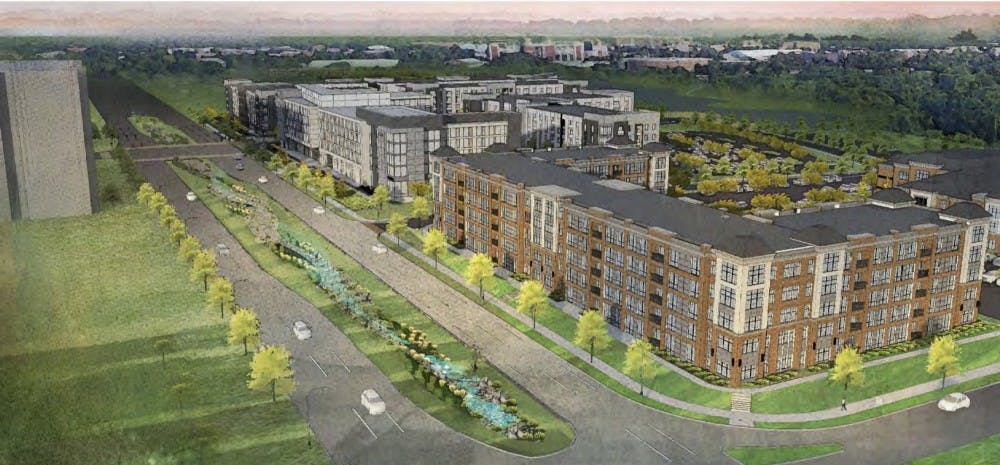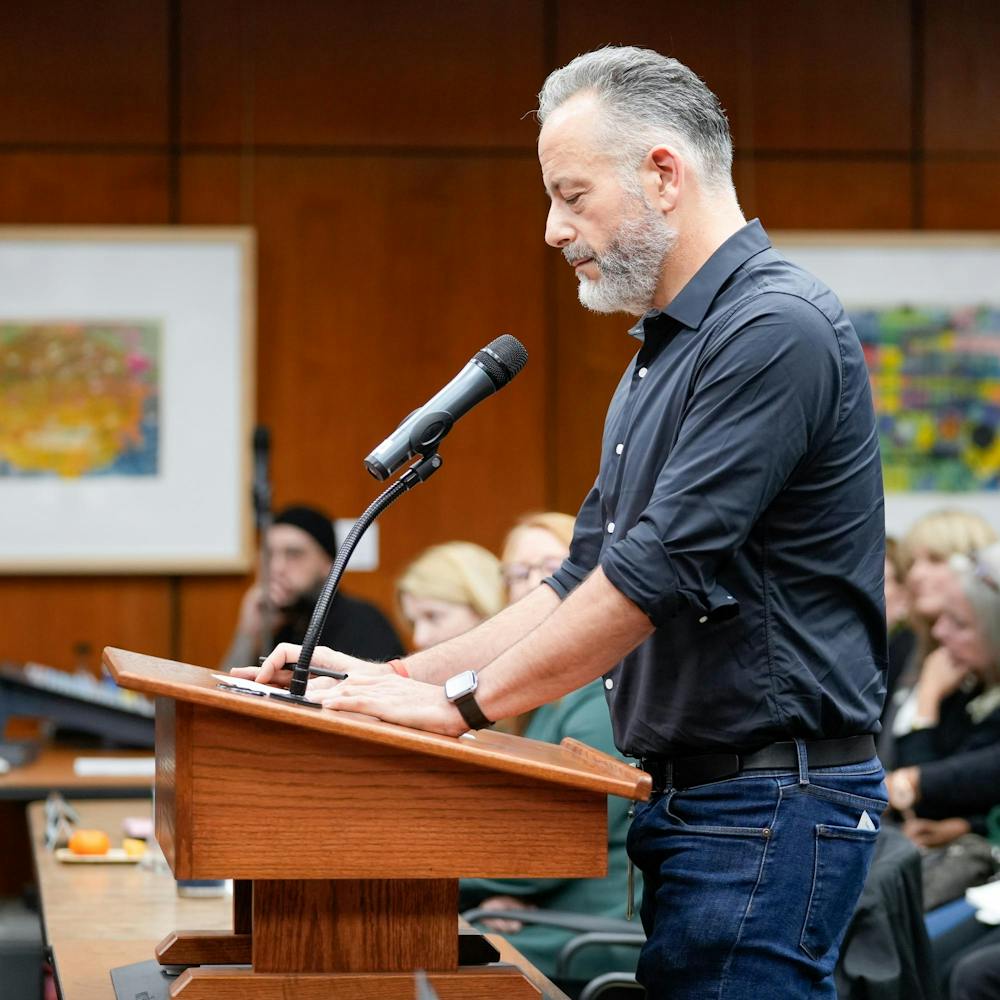A $30 million drain restoration project and a $250 million development project pending approval could drastically reshape the Michigan Avenue corridor, bringing big changes to the Michigan State community and the border between Lansing and East Lansing.
Michigan Avenue could look very different in 5 years

A rendering of the planned Red Cedar development project. COURTESY OF CONTINENTAL/FERGUSON LLC.
Red Cedar redevelopment awaits city approval
MSU Trustee Joel Ferguson and Frank Kass, partners in Lansing-based developer Continental/Ferguson LLC, are spearheading the Red Cedar Development Project.
Before construction can begin, the Lansing City Council must approve a brownfield plan.
Councilmember Jody Washington represents Lansing's 1st Ward, where the proposed project resides. She said residents have been excited about the proposal’s prospects for a long time.
The council approved a comprehensive development plan for the project in 2014, but the project has experienced some major delays before the city's Brownfield Redevelopment Authority approved it last month.
Washington said disagreements stemmed from developers requesting more reimbursement and public bond money than the city was willing to give. Negotiations resulted in less tax money available for use by the developers and the elimination of public bonds in the project's implementation.
“There’s been a lot of back and forth, a lot of disagreement," she said. “We are now at the final stages.”
The developers will be reimbursed for infrastructure improvements to the site through Tax Increment Financing, or TIF, subsidies if the brownfield plan is approved. An estimated 400 full-time jobs and 1,000 "indirect" jobs will be created, according to a project plan submitted to city council Feb. 12.
TIFs can encourage investment in brownfield areas — project sites that had previous developments on them — because developers are reimbursed from the increase in property taxes as the value of the redeveloped property rises.
Taxes that would otherwise go to the city go to the developers instead, helping them pay for infrastructure improvements or other eligible activities unrelated to the development itself.
The project plan estimates its completion by 2024. Taxes from property value would be reimbursed over 30 years, with developers capturing an estimated $123 million in TIF subsidies.
The Lansing City Council has a March 25 public hearing and an April 8 vote scheduled on the brownfield plan.
READ MORE
“In my opinion, this is a good brownfield,” Washington said.
While Washington supports the plan, she isn't so certain about the necessity of further student housing developments.
“I fear that we are hitting a student housing bubble,” she said.
Washington said similar fears prompted the developers to roll out student housing in two phases. If one student housing complex fails to fill up, then the second building could be appropriated for office space.
A tale of two cities
Support student media! Please consider donating to The State News and help fund the future of journalism.
The project proposes a pedestrian walkway connecting East Lansing to Lansing through the Lansing River Trail. East Lansing residents mentioned a lack of connection between the two cities in a February parks and recreation public input meeting.
“Right now, there seems to be this invisible barrier between the two cities,” Washington said.
Christopher Stralkowski, executive project manager for Ferguson Development, said previous student housing developments were further away from campus because people heavily relied on cars and living close to campus wasn’t considered desirable.
“Expectations have changed; the market has changed,” he said. “Development has to fall in line with that.”
Councilmember Washington said there has also been increased commercial interest in the Michigan Avenue corridor.
“I think in the next ten years, we’re not even going to recognize what we have,” Washington said.
Improving water quality in the Red Cedar River
Ingham County Drain Commissioner Pat Lindemann works to provide construction, maintenance and improvement of public storm drains in the county.
Lindemann has already received approvals to redesign the Montgomery Drain, which funnels stormwater runoff into the Red Cedar River at the location of the proposed development.
This project was first introduced in 2016. Lindemann said the project design was about 95 percent finished, and construction is set to begin this summer and last for 2.5 years.
The need for the redesign stems from the fact that the watershed at this location is 80 percent impervious, meaning the asphalt and concrete surrounding Lansing's Frandor Shopping Center permits polluted water to reach the river with little obstruction.
Lindemann said that of the 246 discharges into the Red Cedar River, the Montgomery Drain is the worst source of pollution. Between 50,000 and 75,000 pounds of pollution flow into the river annually, according to Lindemann.
“The project is designed to interrupt the flow to the river and extract the pollution from the flow before it gets to the river,” Lindemann said.
The Red Cedar River flows into the Grand River and eventually Lake Michigan.
Potential solutions include a series of ponds, filtration systems and waterfalls across the corridor.
Lindemann said stormwater runoff that reaches ponds reduces pollution into the Red Cedar River because dissolved heavy metals sink the bottom of ponds rather than continuing to flow into the river. It's then much easier to periodically clean the ponds than to remove pollution from the river.
Using the right plants, pollutants can be filtered as nutrients, preventing pollution from reaching the river, Lindemann said. The goal is to increase dissolved oxygen in the river so microorganisms can biodegrade some pollutants.
Plants can take on water pollutants like iron, copper and zinc. They can also process organic matter like pieces of food or lawn clippings.
Other pollutants would be removed as they hit the rocks on the planned waterfalls, adding more oxygen to the flow of water.
“The waterfalls might look pretty, but that’s not why we’re doing it,” he said.
How the two projects relate
The redevelopment project and the Montgomery Drain redesign will occur in the same corridor, but they are separate undertakings.
“Whether the development happens or not, I’m doing this project,” Lindemann said.
The Drain Commissioner's office would like to see the development project go through, because it would take on nearly one-third of the drain project's overall costs.
“It would be silly for the city not to allow that project to go forward,” Lindemann said.
Drain improvements will cost between $32 million and $34 million, Lindemann said.
The drain office's plan includes 2.5 miles of walking path, a cost the Red Cedar developers agreed to take on if their project is approved. Before buildings can go up, developers would also be required to remove contaminants from the soil.
“If we didn’t have that development going, then that ground pollution would still be there,” Lindemann said.
Even if the redevelopment project fails and isn't able to contribute to the costs of the drain redesign, Lindemann said his office’s low-impact plan would still be a cost-effective solution to the area's pollution problem.
He said wastewater treatment plants can cost up to $90 million and require ongoing operating costs and maintenance.
“This project would be twice as much money, or even three times as much in some cases,” he said.







